Numeral cards, an inner numerology
There's a much overlooked fact about the numeral (or pip) cards, and this fact explains why a strictly numerology based approach would fail : tarot pip cards express a different actualization or materialization of different numbers, and that could be the most fundamental notion information you would need to remember from this text. Papus ne pouvait être plus dans le faux que quand il écrivait :
« Si maintenant vous prenez un des paquets des 14 cartes [les enseignes] vous constaterez qu'il est formé de quatre figures et de 10 autres cartes portant simplement des nombres et des symboles pareils».
« If now you take one of those 14 cards packs [the suits] you'll realize that it is formed by four figures and by 10 other cards simply showing identical numbers and symbols».
Note that in the following short text, the cards ornamental aspect will be mostly ignored, it is not to say that ornamentation would be irrelevant and should be overlooked, on the contrary, but we will focus only on the number of the suits as they are represented - the ornamentation and the way they dance with the numbers would deserve at least another whole text, so we'll pretend to ignore them, but you should stay focused on what we won't say about them.
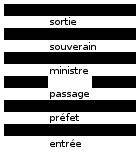
This should be studied in the same manner the I-Ching - the Classic of Changes - hexagrams can be studied, that is apart from their literary meanings - which are the foundations of this Chinese classic - but only based on their visual structure by itself, which can often bring enough information to deduce an interpretation. In the I-Ching 64 hexagrams, in any hexagram each of the 6 lines has a common "function", not unlike the suits in tarot have a "general" domain of expression, and those function can take one of two values (yin lines, the opened ones can be either static or closing, and yang lines either static or opening). Hence from a schematic visual representation, tensions and spaces can be felt and described, from there narratives can unfold, what is happening or what is quiet at such or such floor of the hexagram building.
In the tarot, we don't have 64 hexagram or six lines, but we have 10 numbers, 1 to 10.
Let's look at the Six. It is not expressed or represented in the same way in Coupes, Deniers and Batons. So one should tune his numerology oriented view according to each expression of that same number.
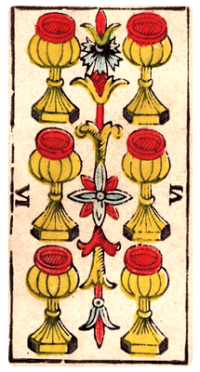
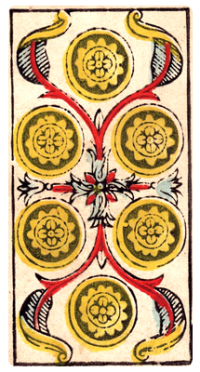
It's a specific feature of Tarot as well as italian and spanish suited cards, while standard playing cards represent all 7s through the same shape for spades, diamonds, clubs or hearts.
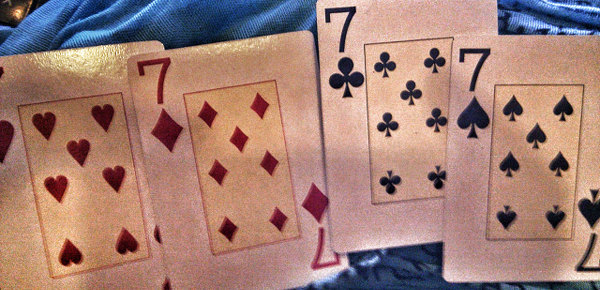
Spanish and Italian suited standard playing cards also offer this feature, but in a different way than tarot.
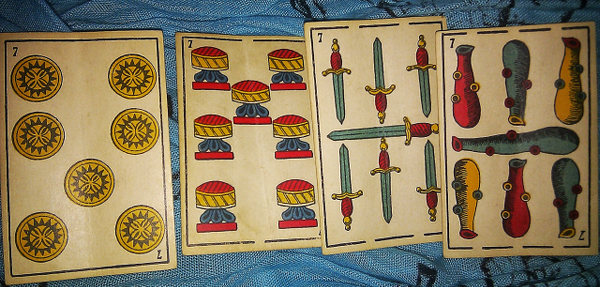
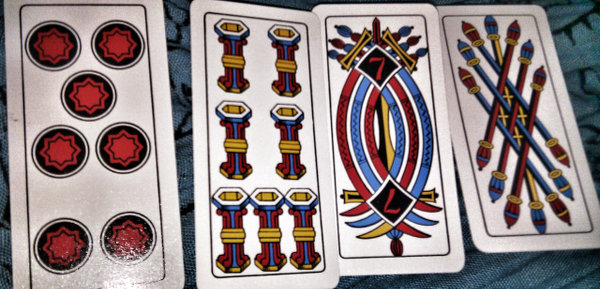
In the Tarot 7 is in the Deniers suit, represented - as in standard playing cards - in the shape of the geomantic figure Albus/Rubeus (not everybody agree on the right-side-up state of this card just like not everybody agrees in geomancy agree on the geomantic albus/rubeus pair orientation). It is indeed a certain combination of the shape of 3 and 4 from the same color.
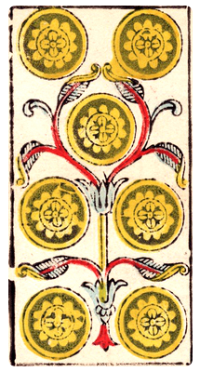
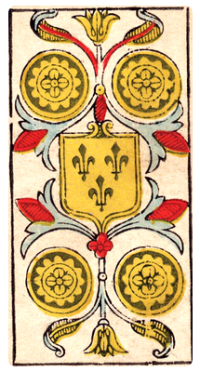
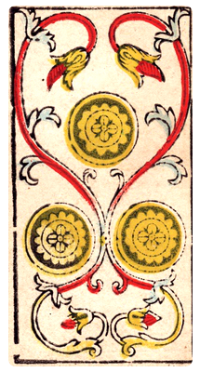
(note : this is not the case for every "Marseille" type tarot deck, for instance Ignaz Krebs deck offers another disposition reminding the geomantic figures Laetitia & Tristitia, again a combination of the 3 and 4 dispositions but with an inverted relation, the three pointing outwards ; the Albus/Rubeus pair is nevertheless characteristic of the majority of the Marseille pattern decks, from some of the oldest french models to their more recent Italian heirs)
This structural similarity with the four and three of deniers, 7 can be read as 3+4, which may be significant as quantities, or through its relations to the 3 and 4 in the whole reading.
If we look at this numerically identical 7, it'll play a whole different game in Coupes, it's a line of 3, a single cup, and another line of 3, the top and bottom are clearly defined thanks to the cups, so as numbers it can be read as 3+1+3, or interpreted as one between two bands, or 1 vs 6.
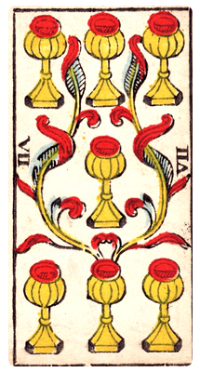
and by its graphical structure it is closer to the 8 of cups (3+2+3) than any other card, so here we've got a relation within a single suit.
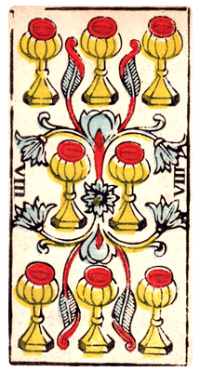
From this point of view the 8 of Deniers and 6 of Coupes are quite structurally similar and we have a relation between two different suits and two different number.
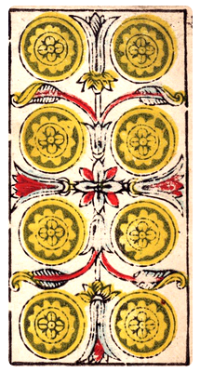

Épées(swords) and Batons emphasize the succession of odds and even numbers, but not in the same fashion : in swords the odds offer a realistic representation of a sword (or a pair of swords for the 10) that reminds the Ace and differs a lot from the more abstract representations of swirling or curved swords, whereas in Batons, the odd baton is quite similar to the rest of the image. Another difference lies in the woven pattern which is external in the swords and central in the batons. Watching only the suits representations, we can see that swords adds two pairs while the batons tend to divide : in the 7, for the épées (swords) we have 3+1 central +3, in the batons, we have a centrifugal explosion of two pairs of three and a one less all emerging from the center, the 1 and 3s expand in the same space instead of the two groups of three defining a space where the 1 resides in the épées.
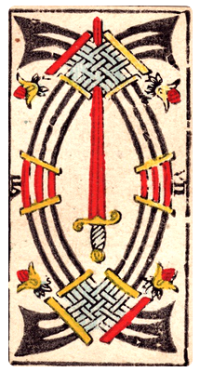
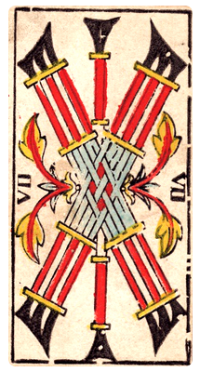
So even though numbers are indeed full of information by themselves, through these different representations we end up with four different materialization (or immaterialization) of each number from 2 to 10 in the numeral cards. Beyond a pre-established numerology, numeral cards offer a detailed visual explanation of their own numerology that they invite us to unfold when reading.
B.S.G. MMXIIII
text updated on the 19th of september MMXXIIII